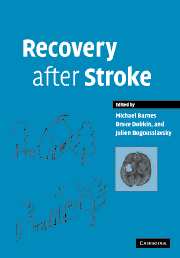Book contents
- Frontmatter
- Contents
- List of authors
- Preface
- 1 Stroke: background, epidemiology, etiology and avoiding recurrence
- 2 Principles of recovery after stroke
- 3 Regenerative ability in the central nervous system
- 4 Cerebral reorganization after sensorimotor stroke
- 5 Some personal lessons from imaging brain in recovery from stroke
- 6 Measurement in stroke: activity and quality of life
- 7 The impact of rehabilitation on stroke outcomes: what is the evidence?
- 8 Is early neurorehabilitation useful?
- 9 Community rehabilitation after stroke: is there no place like home?
- 10 Physical therapy
- 11 Abnormal movements after stroke
- 12 Spasticity and pain after stroke
- 13 Balance disorders and vertigo after stroke: assessment and rehabilitation
- 14 Management of dysphagia after stroke
- 15 Continence and stroke
- 16 Sex and relationships following stroke
- 17 Rehabilitation of visual disorders after stroke
- 18 Aphasia and dysarthria after stroke
- 19 Cognitive recovery after stroke
- 20 Stroke-related dementia
- 21 Depression and fatigue after stroke
- 22 Sleep disorders after stroke
- 23 Technology for recovery after stroke
- 24 Vocational rehabilitation
- 25 A patient's perspective
- Index
14 - Management of dysphagia after stroke
Published online by Cambridge University Press: 05 August 2016
- Frontmatter
- Contents
- List of authors
- Preface
- 1 Stroke: background, epidemiology, etiology and avoiding recurrence
- 2 Principles of recovery after stroke
- 3 Regenerative ability in the central nervous system
- 4 Cerebral reorganization after sensorimotor stroke
- 5 Some personal lessons from imaging brain in recovery from stroke
- 6 Measurement in stroke: activity and quality of life
- 7 The impact of rehabilitation on stroke outcomes: what is the evidence?
- 8 Is early neurorehabilitation useful?
- 9 Community rehabilitation after stroke: is there no place like home?
- 10 Physical therapy
- 11 Abnormal movements after stroke
- 12 Spasticity and pain after stroke
- 13 Balance disorders and vertigo after stroke: assessment and rehabilitation
- 14 Management of dysphagia after stroke
- 15 Continence and stroke
- 16 Sex and relationships following stroke
- 17 Rehabilitation of visual disorders after stroke
- 18 Aphasia and dysarthria after stroke
- 19 Cognitive recovery after stroke
- 20 Stroke-related dementia
- 21 Depression and fatigue after stroke
- 22 Sleep disorders after stroke
- 23 Technology for recovery after stroke
- 24 Vocational rehabilitation
- 25 A patient's perspective
- Index
Summary
Introduction
This chapter will review the nature of swallowing disorders after stroke, the process of evaluation and treatment of dysphagia in stroke patients, and research needs in the area.
Dysphagia is a frequent effect of stroke. It can be short or longterm, mild or severe. Dysphagia can, in turn, cause aspiration and ultimately a costly pneumonia in addition to dehydration and malnutrition. As a result, a great deal of research has, and continues to, examine various aspects of dysphagia post-stroke including methods for its evaluation and treatment.
Swallow disorders by site of lesion
The body of knowledge on swallow abnormalities resulting from stroke at specific sites in the central nervous system is still evolving (Meadows, 1973; Wade and Hewer, 1987; Delgado, 1988; Barer, 1989; Celifarco et al., 1990; Logemann and Kahrilas, 1990; Smith and Dodd, 1990). However, there is adequate information to begin to understand the types of swallow disorder exhibited by patients with isolated lesions in the brainstem, subcortical regions, and left and right hemispheres of the cerebral cortex. The discussion below is based on data from our studies of patients at three weeks post-stroke who have suffered a single infarct with no prior history of stroke or other neurological disorders or damage to the head and neck, and who have been otherwise apparently healthy until their stroke. Medical complications, preexisting medical problems and medications can affect the severity of swallowing problems post-stroke.
There has also been the suggestion in the literature that each individual may have a dominant hemisphere for swallowing, thus explaining the variability in reports of site of lesions causing dysphagia (Hamdy et al., 1996, 1997, 1998a,b, 2000, 2001; Hamdy and Rothwell, 1998; Fraser et al., 2002). This research group has reported that “dysphagia after unilateral hemispheric stroke is related to the management of pharyngeal motor representation in the unaffected hemisphere” (Hamdy et al., 1996).
Effects of lesions in the brainstem
Lesions in the lower brainstem (medullary region) generally result in significant oropharyngeal swallow impairment because of the location of the major swallow centers (nucleus tractus solitarius and nucleus ambiguous) within the medulla (Jean and Car, 1979; Miller, 1982).
- Type
- Chapter
- Information
- Recovery after Stroke , pp. 397 - 414Publisher: Cambridge University PressPrint publication year: 2005



